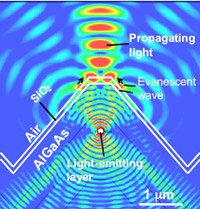May 11 2010
Wang XueLun, Near-Field Nano-Engineering Group, Nanotechnology Research Institute, the National Institute of Advanced Industrial Science and Technology, succeeded in extracting light from a semiconductor into air with the highest efficiency.
For this purpose, ridges were fabricated on a semiconductor surface, and then, the fabricated ridges were coated with a silicon dioxide (SiO2) layer. The mechanism of the light-extraction with high efficiency was also clarified.
 Simulation results showing the efficient extraction of light generated in a light-emitting layer into air through a ridge-top flat plane
Simulation results showing the efficient extraction of light generated in a light-emitting layer into air through a ridge-top flat plane
Strong total internal reflection normally occurs at the interface between a semiconductor and air because the refractive index of a semiconductor material is usually far greater than that of air. For this reason, efficient extraction of the light generated in a semiconductor material into air becomes very difficult. For example, in the case of light-emitting semiconductor materials deposited on flat substrates, one can extract only a few percent of the total amount of light generated in the semiconductors (gallium arsenide (GaAs): ~2%, gallium nitride (GaN): ~4%). This serious problem hinders the improvement of the efficiency of various semiconductor optical devices such as light-emitting diodes (LEDs).
Previously, it was discovered that the aforementioned light-extraction efficiency could be significantly improved by fabricating narrow ridges on the surface of semiconductor materials. In this study, we fabricated ridges on a semiconductor surface and coated the ridges with a thin film made of a material (e.g., SiO2) whose refractive index was lower than that of the semiconductor. The light-extraction efficiency in this case was 1.5 times higher than that achieved in the previously discovered method. Our new method can be used to improve the efficiency of various semiconductor optical devices, especially LEDs, which are promising candidates for energy-efficient light sources that can be used in lighting and display applications.
The results of the present study will be presented on March 20, 2010, at the 57th Spring Meeting, 2010, of the Japan Society of Applied Physics to be held at Shonan Campus, Tokai University.